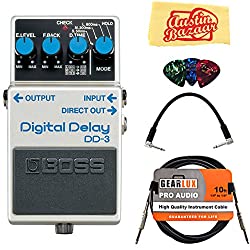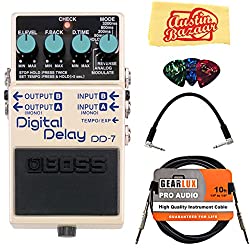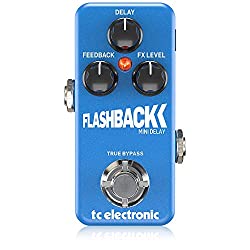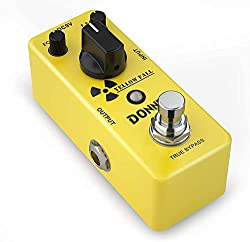As a musician who uses pedals, I’m always on the lookout for new products.
I used to find it difficult to find a pedal that was good quality and affordable.
When I found the Boss DD-3 Digital Delay Pedal, I knew I hit the jackpot. Let’s take a look and review this model.
Things to Consider Before Buying a Delay Pedal
Choosing the right delay pedal will be a unique process depending on the type of musician you are.
The Boss Delay DD3 will solve the problem of finding a high quality pedal with a simple setup. However, before you purchase this pedal, remember to consider:
- How traditional you want the effects to be
- The type of sound you’re looking for (this pedal has an analog sound)
If you’re hoping to create some abstract effects, you might want to consider a different model, such as the Red Panda’s granular delay pedal.
If you’re experienced with pedals and want to experiment with a complex sound, check out this article on how to set up a pedal chain.
The Boss DD 3 Review
Before I talk about the specifics of this model, it’s important to know what a delay pedal does.
All delay pedals will take your audio signal and repeat it back to you as quickly as you want. You can also affect how many repeats you’ll hear.
In comparison to other leading delay pedals like the Boss DD-7, this pedal has a simpler setup and fewer features, making it a better fit for musicians who want a traditional sound.
Pros
- Easy to use
- Durable
- Great analog sound
Cons
- Less delay time than the DD-7
- No modulation feature
- No reverse feature
Features of Boss DD-3 Digital Delay Pedal
While this pedal doesn’t have as many features as some other pedals on the market, part of its charm is in the simplicity of its design.
Characteristic of all Boss pedals, this model is super durable.
If you’re a traveling musician, this model might be a good choice because of everything it can withstand.
The Boss DD3 price is also lower than other pedals, which is another great feature for musicians on a budget.
1. Mode Knob
The mode knob on this pedal will allow you to choose between three different time settings and one extra setting: 50 ms, 200 ms, 800 ms, and a hold setting.
The 50 ms second setting will give you an extremely short delay time, so the effect will be very subtle.
Likewise, 200 ms of delay time will give you a pretty subtle delay effect. The 800 ms setting will give you a much more noticeable effect.
However, if you’re looking for a really large gap between your repeats, I’d suggest exploring other pedals.
For example, the DD-7 has a 3200 ms mode. Your hold setting will allow you to create a loop if you leave your foot on the pedal, which is great for stacking harmonies or practicing improvisation.
2. Delay Time Knob
The Delay Time knob on this pedal is used to adjust the amount of time that occurs between each of your repeats. While the highest settings on the D.
Time knob will lead to longer periods of time between playbacks, the lower settings will create short periods of time.
If you want to create an illusion of a very reverberant setting, you’ll probably want to use the maximum settings of this knob.
On the other hand, to create the impression of a less reverberant space, use the lower settings.
3. Feedback
This knob can be used to control how many repeats you hear from your delay pedal. If you only want to hear a single repeat, turn the feedback knob down to the lowest setting.
For infinite repeats, turn the feedback knob up to the maximum settings.
The more repeats you hear, the more you’ll feel like you’re in a huge reverberant space, such as a cathedral.
4. E. Level Knob
The E. Level or effect level knob is how you will affect the volume of your output sound.
In my experience, it’s best to use the other knobs first to come up with your ideal sound, and then use this knob to amplify that effect.
Alternatives
If you don’t feel that this will be the best choice of delay pedal for you, you might want to consider some other models. Here are some alternative pedals:
1. The Boss DD-7 Digital Delay Pedal
This is another leading delay pedal on the market and is the offspring of the DD-3 model.
This pedal is similar in quality but has less of an analog sound than the DD-3.
This pedal has more features, including a modulation and reverse feature, making it a good fit for advanced musicians.
Pros
- Reverse setting
- Modulation setting
- Longer delay time
Cons
- Less of an analog sound
- More expensive
- Not as beginner-friendly
2. The TC Electronic Flashback Mini Delay Pedal
This pedal is a great choice for musicians who want a smaller device that will fit well on a pedalboard.
Since this pedal is so much smaller, there are also fewer features and small knobs.
However, TC Electronic is a great brand that provides high quality products.
Pros
- Small size fits well on pedalboard
- Simple design
- High sound quality
Cons
- Small knobs
- Fewer features
- Less delay time than larger devices
3. Donner Yellow Fall Vintage Pure Analog Delay Pedal True Bypass
This model is a good choice for musicians who are looking for a delay pedal on a budget.
Musicians who own this pedal are always surprised and awed by the high quality sound they produce despite such a low price.
These pedals are also small, and they’ll, therefore, have fewer features than other devices.
Pros
- Affordable
- Great sound
- Small size makes it fit great on a pedalboard
Cons
- No modulation effects
- Small knobs
- Less delay time than larger devices
Conclusion
Hopefully you found this review of the Boss DD-3 Settings useful.
This pedal solves the age-old problem of not being able to find a high quality pedal with a simple setup.
This Boss pedal is durable and has a great analog effect perfect for vintage rock music.





